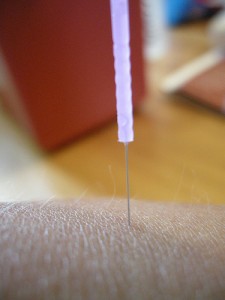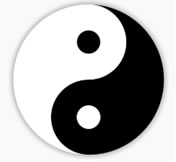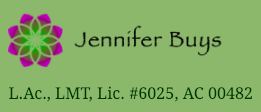Many people have questions about acupuncture—what it feels like, how it works, and what to expect in a treatment. Below you will find answers to some of those questions.
I think it is important to acknowledge that everyone responds differently to acupuncture, and every acupuncturist is slightly different in how they practice. Acupuncture has been practiced as an effective form of medicine for over 2500 years, and over time different perspectives and theories have developed. Each perspective has its validity, at the appropriate time and place; they can be likened to lenses through which we can view the patient and their primary imbalances. Acupuncture and Oriental Medicine is like any medicine or art—the person practicing it inherently influences the way in which it is practiced.
What does it feel like?
 Some people have fear or anxiety when they think of needles. This may arise, in part, to associations created from having blood drawn as well as vaccinations and shots throughout our lives. In these procedures, larger, hollow-tip needles are used which can sometimes cause pain. This is very different from acupuncture needles, which are not hollow-tipped, and can be as thin as a human hair.
Some people have fear or anxiety when they think of needles. This may arise, in part, to associations created from having blood drawn as well as vaccinations and shots throughout our lives. In these procedures, larger, hollow-tip needles are used which can sometimes cause pain. This is very different from acupuncture needles, which are not hollow-tipped, and can be as thin as a human hair.
There are many different sensations that can be experienced when the needles are inserted and retained. You may feel an ache or soreness, a warmth, a distending or full sensation at the site of insertion, a “zing” that comes and goes, or a spreading sensation. All of these are considered to be therapeutic sensations, indicating that the points and channels are active and your body is starting to shift. However, if it is ever too strong, sharp, or uncomfortable, then it is important to let your practitioner know, even if it is one of the therapeutic sensations.
One of the most important aspects of a treatment is that you are able to relax as completely as possible. The more you are able to relax and release any tension in your body, the more effective the acupuncture treatment can be. Therefore, if you experience anything that brings lasting tension into your body, it is important to say something. This communication between patient and practitioner is vital in any healing relationship.
How it “works”
 To understand how acupuncture functions to assist each individual in healing, we need to understand some of the fundamental theory and philosophy upon which Chinese medicine is based. A lot of this is metaphorical, providing a beautiful way in which to visualize humanity and how we are intrinsically connected to our natural environment. To the ancient Chinese, humans are seen as the “Middle Kingdom”, between Heaven above and Earth below. You have probably heard of Yin and Yang; in this view Heaven corresponds to Yang and Earth corresponds to Yin. Yang qi, or Yang energy, flows down from Heaven and into the Earth, and Yin qi flows from up from Earth to Heaven, thus keeping Heaven and Earth constantly connected, as part of one universal whole. Everything that exists at the level of humanity, including humans themselves, becomes conduits for this energetic flow between Heaven and Earth. Indeed, the Chinese believe that it is this flow that gives rise to all that is present at this level.
To understand how acupuncture functions to assist each individual in healing, we need to understand some of the fundamental theory and philosophy upon which Chinese medicine is based. A lot of this is metaphorical, providing a beautiful way in which to visualize humanity and how we are intrinsically connected to our natural environment. To the ancient Chinese, humans are seen as the “Middle Kingdom”, between Heaven above and Earth below. You have probably heard of Yin and Yang; in this view Heaven corresponds to Yang and Earth corresponds to Yin. Yang qi, or Yang energy, flows down from Heaven and into the Earth, and Yin qi flows from up from Earth to Heaven, thus keeping Heaven and Earth constantly connected, as part of one universal whole. Everything that exists at the level of humanity, including humans themselves, becomes conduits for this energetic flow between Heaven and Earth. Indeed, the Chinese believe that it is this flow that gives rise to all that is present at this level.
In one of the earliest known texts on Acupuncture and Oriental Medicine, it is stated that “Happiness is when the Qi flows freely through the body.” This may be interpreted as meaning that as long as this flow between Heaven and Earth is smooth, we have a nearly unlimited capacity to heal, to be healthy and happy, and to live fulfilled lives full of awareness. How is this so? We all have meridians, or channels, that run through our body and act as conduits for this constant flow of qi. The yang meridians start at the fingertips, carrying yang qi from Heaven above to the head and body and eventually down to the toes and the Earth. The yin meridians start at the toes, carrying yin qi from Earth up to the body and eventually out the fingertips and up to Heaven. If this flow of qi is unobstructed, it can carry out any excesses and fill any deficiencies, thus allowing the body’s natural capacity to heal to be at its fullest.
When the qi flows freely through the body, there are no blockages and one feels relaxed and present. Through diagnosing which meridians and organs may have potential blockages, we can then use acupuncture to stimulate those meridians and organs to return to the natural state. For this reason, many people find acupuncture to be extremely relaxing; some will even fall asleep while the needles are in. This is often an excellent sign, for when a person reaches the state between sleeping and waking, there is a systemic relaxation that occurs, thus allowing the needles to be even more effective. If you are still extremely relaxed or even “spacey” after the treatment, it is a good idea to sit for a few minutes and simply be present with what you are experiencing. Sometimes you may even want to go home and take a nap after a treatment, which is an excellent idea if you have flexibility in your schedule. Other times people will feel extremely energized and awake after a treatment; if this is the case it is also excellent, but be careful not to push yourself too much—especially if you were treated for any form of physical pain or injury. It is very easy to overdo-it and re-injure the affected body part within the first 24 hours of treatment if you push yourself too hard.
Treatment schedule
Acupuncture and Oriental medicine are not designed to be a magic bullet. There are many times when a single acupuncture treatment may be all that is required, especially if you are coming in for an acute (recent) injury or illness. However, for more chronic, severe, and long-term conditions, multiple treatments will often be necessary. In such cases, I often recommend that patients come in 2-3 times/week for 2-3 weeks, and then start spacing out the treatment periods after that—often going to once/week for several weeks, and then slowly increasing the interval between treatments. When you receive several treatments close together at the beginning, there is a synergistic effect that allows the body to shift and adapt more quickly. However, if we do not see a significant shift within 2-4 treatments, I will often refer you out to other practitioners and modalities.
In China, it is common for individuals to receive acupuncture 5 times/week, several weeks in a row, for severe and chronic issues such as stroke recovery, bulging/herniated discs and sciatica, insomnia, and other issues. However, there it is integrated in the hospital setting; in the United States at this point it is less feasible for patients to come in that often given financial and scheduling issues. However, we can often see similar strong results when patients come 2-3 times/week at the start.
Commonly Treated Conditions
- Stress
- Allergies/Sinus Congestion
- Pain Relief
- Sports injuries
- Sciatica
- Insomnia
- Anxiety/Depression
- Headaches
- Post-operative pain
- Post-Traumatic Stress Disorder (PTSD)
- Hormonal imbalances
- Digestive issues
- PMS
- Gynecological issues (Pelvic pain, PMS)
- Menopausal issues (Hot flashes, night sweats)
- Infertility
